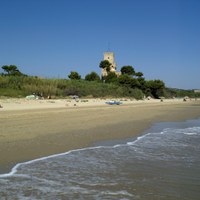Nature and Protected areas
Protected seashore area "Torre del Cerrano"
Standing between Pineto and Silvi the Protected seashore area runs along 7 km of coast and stretches up to 3 nautical miles.
The entire area covers about 37 kmq and has 3 areas with different degrees of protection: the restricted zone B (about 1 km) facing the Torre Cerrano, the zone C (14 kmq) which stretches along the entire length of coastline up to 2 km out to sea, and, finally, the wide zone B with its trapezoidal shape (22kmq) extends up to a further 3 nautical miles. (here there is the physical reference reaching a depth of 17 mt made up by the summerged barriers of the fish repopulation Oasis).
The sea
The small area of the Seashore Area introduces two distinguishing environmental typologies and connected themselves: the typical adriatic sandy backdrops ( characterizing the widest portion of the area) and some parts of bluffs leading, determineted by both the submerged rocks of the Atri's port and the semisubmerged structures of the Provincial Seashore Protection Oasis, besides some protruding of geological congolmerate formations.
In the area lives a large number of marine animal species (pelagic and betonico) and a small but various group of vegetal species. Besides the beatiful specimen of the small and rare Adriatic Gasteropode such as the Trivia adriatica and the imposive bioconstructions of Sabellaria halcocki, in the underwater environment it's easy to find various species of fish and shellfish. Over all there are the gronco, the seabass, the sole and the sarago all living in the sandy backdrops characterized by wide benches of Chamelea hen (common clam).
Sand dune
the sandy cords, laying alongside the coastline, grow besides the area subject to tide's changes thanks to the drifting of sandy particles carried on the wind.
It's an important area of transition between sea and dry land. The sea storms, the high degree of present salinity both in the air and in the substratum, the strong winds, the high sun's irradiance and
the lack of organic substance in the ground allow the growing of some particular species: insect such as the Scarabeus semimpunctatus and the rare Lamprindodes pictus besides some rare species of avifauna. Here nests the fratino, a migrant bird coming to the beach from April to late September and coming back each spring for the laying of the eggs.
The vegetation
The dunale psammofila vegetation with its beatiful specimen of Giglio di mare, Verbasco del Gargano, di Soldanella marittima e di Euforbia delle spiagge is very interesting. In the southern area, at the back of the pine woods of Pino de pinoli and aleppo, there is a thick population of the very rare Zafferanetto delle spiagge.
Furtheremore, inside the Cerrano Tower, ancient tower of sighting of the XVI century, there is the Reparto Biologia Marina e Fluviale of the Istituto Zooprofilattico Sperimentale dell'Abruzzo e del Molise "G. Caporale" in which is situated an experimental high technology plant of acquacoltura .

















